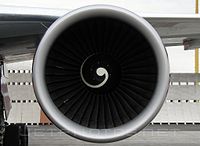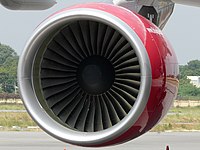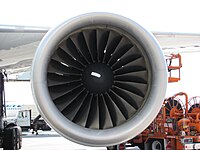Pratt & Whitney PW4000
| PW4000 | |
|---|---|
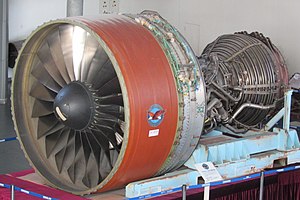
| |
| The 112-inch (2.8 m) fan diameter PW4098 used on the Boeing 777 | |
| Type | Turbofan |
| National origin | United States |
| Manufacturer | Pratt & Whitney |
| First run | April 1984[1] |
| Major applications | Airbus A300-600/Airbus A310 Airbus A330 Boeing 747-400 Boeing 767/KC-46 Boeing 777 McDonnell Douglas MD-11 Scaled Composites Stratolaunch |
| Produced | 1984–present |
| Number built | 2,500 (June 2017)[2][needs update] |
| Developed from | Pratt & Whitney JT9D |
| Developed into | Engine Alliance GP7000 |
The Pratt & Whitney PW4000 is a family of dual-spool, axial-flow, high-bypass turbofan aircraft engines produced by Pratt & Whitney as the successor to the JT9D. It was first run in April 1984, was FAA certified in July 1986, and was introduced in June 1987. With thrust ranging from 50,000 to 99,040 lbf (222 to 441 kN), it is used on many wide-body aircraft.
Development[edit]
The 52,000–62,000 lbf (230–275 kN), 94 in (2.4 m) -fan PW4000 made its first run in April 1984, was FAA certified in July 1986, and was introduced in June 1987. It powers the Airbus A300-600 and Airbus A310-300, Boeing 747-400 and 767-200/300, and McDonnell Douglas MD-11 widebodies.[1]
Development of the 64,000–68,000 lbf (280–300 kN), 100 in (2.5 m)-fan version began in December 1991 for the Airbus A330, was FAA certified in August 1993, and made its first flight two months later. It received 90min Extended-range Twin-engine Operations (ETOPS) approval at introduction in December 1994, and 180min ETOPS approval in July 1995. In January 2000, it was the A330 market leader with more than half of the installed base and one million hours, more than twice that of each competitor.[1] The Advantage 70 upgrade package for the PW4168A, which powered around one-third of the active Airbus A330 fleet, was launched at the 2006 Farnborough Airshow, increasing thrust to 70,000 lbf (311 kN), and reducing fuel burn by about 1.2% as well as overall operating costs by as much as 20%.[3]
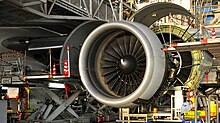
For the Boeing 777, the 84,000–98,000 lbf (370–440 kN), 112 in (2.8 m)-fan version development began in October 1990, achieved 100,000 lbf (440 kN) in May 1993, and was approved for 180min ETOPS at service entry in June 1995.The 777 launch engine, it entered service on 7 June 1995, with United Airlines. The 90,000 lbf (400 kN) PW4090 entered service in March 1997. The 98,000 lbf (440 kN) PW4098 received FAA certification in July 1998 and was introduced on the Boeing 777-300 in September 1999 but was a few years later discontinued due to core temperature problems and fuel burn that was not appealing to airlines..[1]
In 2000, over 2,000 PW4000 engines had accumulated over 40 million hours of service with 75 operators.[1] In 30 years between June 1987 and 2017, more than 2,500 engines have been delivered, logging more than 135 million flight hours.[2]
Design[edit]

The PW4000 has a dispatch reliability rate of 99.96% and is approved for ETOPS 180. The average engine stays on wing 13,500 flight hours before a shop visit (a Shop Visit Rate of 0.073 per thousand hours). It is claimed to be cumulatively 3.4 dB quieter than other engines in its class.[1]
Like other modern aircraft power plants, it has a Full Authority Digital Engine Control (FADEC), for better fuel economy and reliability.[4] Furthermore, single-crystal alloys allows higher temperature capability and PW's Floatwall combustor liners improve durability and maintainability.[1] Also, the Talon ("Technology for Affordable Low NOx") single-row combustor improves fuel-air mixing, for over 10% better NOx, CO, and HC emissions.[1]
Variants and applications[edit]
The PW 4000 series engine family uses a numbering systematic with the last three digits (PW 4XYZ) as identification of the application and thrust power:
- X describes the aircraft manufacturer for which the engine is approved. A "0" stands for Boeing 767, 747, 777; "1" for Airbus A300, A310, A330; and "4" for the McDonnell Douglas MD-11.
- YZ denotes the certified thrust in US pounds (lbf) in pro-mile fraction.
Example: A PW4077 identifies a PW4000 series engine certified for Boeing (777-200) and has a certified thrust of 77,000 lbf.
PW4000-94[edit]
Variants: PW4052, PW4056, PW4060, PW4062, PW4062A, PW4152, PW4156A, PW4156, PW4158, PW4460 and PW4462.
Thrust range: 231–276 kN (52,000 lbf – 62,000 lbf)[5]
Applications:
- Airbus A300-600
- Airbus A310-300
- Boeing 747-400, Boeing Dreamlifter (and Scaled Composites Stratolaunch)
- Boeing 767-200/-300/-400(Including ER Version and Boeing Converted Freighter version except -300F)/-2C/Boeing KC-46A
- McDonnell Douglas MD-11
- Boeing KC-46A
PW4000-100[edit]
Variants: PW4164, PW4168, PW4168A and PW4170.
Thrust range: 287–311 kN (64,500 lbf – 70,000 lbf)[6]
Applications: the engine variants are designed exclusively for Airbus A330-200 and -300 (Note that this does not include the A330neo: -800 or -900 nor the BelugaXL (A330-700)).
PW4000-112[edit]
Variants: PW4074/74D, PW4077/77D, PW4084/84D, PW4090 and PW4098.
Thrust range: 329–436 kN (74,000 lbf – 98,000 lbf)[7]
Applications: the engine variants are designed exclusively for Boeing 777-200, -200ER, -300. (Note that this does not include the -200LR, -300ER or F).
Accidents and incidents[edit]

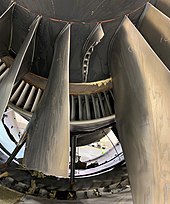
Involving PW4000-112 series[edit]
- 17 March 2003, United Airlines Flight 842
- A PW4090 failed bearing caused the engine loss and the diversion to Kona, Hawaii, of a Boeing 777-200ER bound from Auckland, New Zealand, to Los Angeles. At 190 minutes this was the longest single-engine diversion on record at the time. [8][9][10]
- 27 May 2016, Korean Air Flight 2708
- A PW4098 uncontained turbine failure caused an aborted take-off,[11][12] on a Boeing 777-300 at Tokyo-Haneda Airport.[13]
- 13 February 2018, United Airlines Flight 1175
- A PW4077 fan blade failure caused significant engine damage to a Boeing 777-200 on descent into Honolulu from San Francisco.[14] Routine fan blade inspection in 2005 and 2010 had shown a crack in the blade's metal structure but insufficiently trained inspectors had confused it for a defect in the paint. [15][16] In 2019, an airworthiness directive mandated recurring engine inspections based on usage cycles.[17]
- 4 December 2020, Japan Airlines Flight 904
- A PW4074 engine had a fan blade failure and associated engine cowl damage as the Boeing 777-200 was climbing out of Okinawa.[18] As of March 2021 the investigation is ongoing.
- 20 February 2021, United Airlines Flight 328
- Boeing 777-200's right hand PW4077-112 had a blade failure shortly after taking off from Denver, causing significant engine damage.[19] Two fan blades had broken off: one had suffered metal fatigue and possibly chipped another blade which also broke off.[20] The failed blade was compliant with the inspection interval set by the FAA following the 2018 incident. The FAA grounded the affected 777s and issued an emergency Airworthiness Directive on 23 February, requiring a Thermal Acoustic Inspection (TAI) of the -112 fan blades before next flight.[21][22] Japanese authorities and the UK's CAA followed suit,[23] grounding 69 in-service and 59 in-storage Boeing 777s.[24][25] Most carriers had voluntarily grounded the aircraft before, except South Korea's Jin Air's four aircraft.[26] As of March 2021 the investigation is ongoing.
There is more in depth info (Mainly NTSB findings) to this incident on: https://avherald.com/h?article=4e35503b
Involving PW4000-100 series[edit]
- 6 May 2014, Vietnam Airlines VN-A371
- Uncontained failure of a PW4168A low-pressure turbine's stage four causing an Airbus A330 rejected take-off at Melbourne Airport in Australia.[27]
- 13 February 2018, Delta Air Lines Flight 55
- PW4168 fire in an Airbus A330-200 climbing from Lagos (Nigeria) at 2000 feet.[28]
- 18 April 2018, Delta Air Lines Flight 30
- Airbus A330-323's PW4168A fire after takeoff from Atlanta,[29][30] investigated by the NTSB and the French BEA.[31]
Involving PW4000-94 series[edit]
- 7 June 2017, Delta Airlines flight 276
- Metallic debris in a PW4056 tailpipe and a 360 degrees crack in the LP turbine case just forward or the rear flange caused a Boeing 747-400 cruising at FL320 to return to Tokyo Narita.[32] All of the HPC airfoils from the 5th to the 15th stage were damaged with nicks, dents, and tears to the leading and trailing edges and/or were broken off at various lengths above the blade root platforms. The HPT and LPT also had extensive damage, and the LPT case had a 360° split in line with the 6th stage turbine rotor.[32] The NTSB reports 38 airfoil fractures of the 5th stage compressor blade before the part was updated.[32]
- 20 February 2021, Longtail Aviation Flight 5504
- Boeing 747-412BCF PW4056 failure shortly after taking off from Maastricht Aachen Airport : falling turbine blades slightly injured two persons on the ground, the airplane was able to land safely at Liège Airport.[33][34][35][36]
- 28 March 2022, United Airlines Flight 134
- Boeing 767 powered by Pratt & Whitney PW4060 engines experienced fan blade separation on the right-side (number 2) engine during a flight from New York to Zürich. The incident occurred over the Atlantic Ocean. The aircraft diverted to Shannon, Ireland, and landed safely with 123 persons on board.[37]
Specifications[edit]
The PW4000 is produced in three distinct models, with differing LP systems to address different thrust needs.
| Variant | -94[38] | -100[39] | -112[40] | |
|---|---|---|---|---|
| Type | Two spool high bypass ratio Turbofan | |||
| Length | 153.6 in (390 cm) | 167.2 in (425 cm) | 190.4 in (484 cm) | |
| Weight | 9,420 lb 4,273 kg |
12,900 lb 5,851 kg |
15,095–15,741 lb 6,847–7,140 kg |
16,260 lb 7,375 kg |
| Compressor | 1 fan, 4 LP, 11 HP | 1 fan, 5 LP, 11 HP | 1 fan, 6 LP, 11 HP | 1 fan, 7 LP, 11 HP |
| Combustor | Annular | |||
| Turbine | 2 HP, 4 LP | 2 HP, 5 LP | 2 HP, 7 LP | |
| Thrust | 50,000–62,000 lbf 222–276 kN |
64,500–70,000 lbf 287–311 kN |
77,440–91,790 lbf 344–408 kN |
91,790–99,040 lbf 408–441 kN |
| Variant | -94[41] | -100[42] | -112[43] | |
| Fan | 94 in (239 cm) | 100 in (254 cm) | 112 in (284 cm) | |
| Bypass ratio | 4.8–5:1 | 4.9:1 | 5.8–6.4:1 | |
| Overall pressure ratio | 27.5–32.3 | 32.0–34.1 | 34.2–42.8 | |
| Fan pressure ratio | 1.65–1.80 | 1.75–1.76 | 1.70–1.80 | |
| Applications | B747-400, B767, MD-11 A300-600, A310 |
A330 | B777 | |
See also[edit]
Related development
Comparable engines
- Aviadvigatel PS-90
- General Electric CF6
- General Electric GE90
- Pratt & Whitney PW2000
- Progress D-18T
- Rolls-Royce RB211
- Rolls-Royce Trent 700
- Rolls-Royce Trent 800
Related lists
References[edit]
- ^ a b c d e f g h "PW4000 derivatives continue to drive engine success story". Flight Daily News. 23 February 2000.
- ^ a b "Pratt & Whitney Commemorates 30 Years of PW4000-94 Engine Power" (Press release). Pratt & Whitney. 21 June 2017.
- ^ "P&W reveals 'Advantage 70'". Flight Daily News. 14 March 2006.
- ^ Jeff Schweitzer, Pratt & Whitney (14–17 July 2003). "Propulsion Technology Readiness for Next Generation Transport Systems". AIAA International Air and Space Symposium and Exposition. doi:10.2514/6.2003-2787. ISBN 978-1-62410-165-6.
- ^ Pratt & Whitney. "PW4000-94". Retrieved 20 July 2019.
- ^ Pratt & Whitney. "PW4000-100". Retrieved 20 July 2019.
- ^ Pratt & Whitney. "PW4000-112". Archived from the original on 19 July 2019. Retrieved 20 July 2019.
- ^ Ott, James (24 March 2003). "Record Diversion". Aviation Week. Aviation Week Network. Retrieved 7 March 2021.
United Airlines' Boeing 777 carrying 255 passengers flew over the mid-Pacific Ocean against strong headwinds for 192 min. under single-engine power Mar. 17 to land without incident at Kona on the western coast of the big island of Hawaii. Boeing confirmed that it was the longest single-engine diversion during Extended Twin Operations (ETOPS) since the advent of transoceanic twin-engine flights 20 years ago...
- ^ Leonardo, David (25 March 2003). "Engine-failure 777 busts ETOPS limit : Pacific incident was longest ever single-engine diversion". Flight Global. Retrieved 7 March 2021.
A United Airlines Boeing 777-200ER was forced to fly a 190min diversion on one engine over the Pacific Ocean when it had been dispatched on a 180min limitation, according to the US Federal Aviation Administration. Boeing confirms that this is the longest ever single-engine diversion under extended-range twin-engine operations (ETOPS) rules.
- ^ DeSantis, J. Angelo (2013). "Engines Turn or Passengers Swim: A Case Study of How ETOPS Improved Safety and Economics in Aviation". Journal of Air Law and Commerce. 77 (4): 6.
For 177 minutes, Flight 842 flew against headwinds on a single engine."At the top of the descent into Kona, the crew informed passengers of the situation, and shortly thereafter Flight 842 landed safely." A failed No. 3 bearing in the right engine had caused the engine loss.
- ^ "BREAKING Korean Air Boeing 777-300 #KE2708 evacuated at Haneda Airport in Tokyo after engine fire". Air Live Net. 27 May 2016.
- ^ "Accident: Korean B773 at Tokyo on May 27th 2016, rejected takeoff due to engine fire". The Aviation Herald. Archived from the original on 16 November 2017. Retrieved 27 May 2016.
- ^ "KE2708 Flight, Korean Air, Tokyo to Seoul". www.flightr.net. Archived from the original on 7 November 2016. Retrieved 6 November 2016.
- ^ "Incident: United B772 over Pacific on Feb 13th 2018, fan blade, engine cowl and inlet separated in flight, blade debris impacted fuselage".
- ^ NTSB Report PDF https://app.ntsb.gov/pdfgenerator/ReportGeneratorFile.ashx?EventID=20180213X95634&AKey=1&RType=Final&IType=IA
- ^ Alan Levin, Julie Johnsson (22 February 2021). "Boeing 777 Engine Blast Spurs Grounding of Some Older Jets". Bloomberg. Retrieved 23 February 2021.
- ^ "FAA orders fan blade inspections after pattern of engine-related failures". Seattle Times. 23 February 2021.
- ^ Hradecky, Simon (4 December 2020). "Incident: JAL B772 at Okinawa on Dec 4th 2020, engine shut down in flight after uncontained failure, parts of engine cowl dropped". The Aviation Herald. Retrieved 19 July 2021.
- ^ "Incident: United B772 at Denver on Feb 20th 2021, engine inlet separates from engine, engine fire".
- ^ "Boeing 777: Signs of 'metal fatigue' found on Denver plane engine". BBC News. 23 February 2021.
- ^ Josephs, Leslie (22 February 2021). "United takes 24 Boeing 777s out of service as the FAA orders inspections following engine failure". CNBC. Retrieved 22 February 2021.
- ^ Airworthiness Directive, Emergency (23 February 2021). "AD". FAA. Retrieved 24 February 2021.
- ^ "Incident: United B772 at Denver on Feb 20th 2021, engine inlet separates from engine, engine fire".
- ^ "Boeing 777: Dozens grounded after Denver engine failure". BBC News. 22 February 2021.
- ^ Kaminski-Morrow, David (22 February 2021). "UK bans operations with PW4000-powered 777s". Flight Global. Retrieved 23 February 2021.
- ^ Ahlgren, Linnea (24 February 2021). "FAA Releases PW4000 Airworthiness Directive Following 777 Engine Failure". Simpleflying.
- ^ "Engine failure involving Airbus A330, VN-A371" (PDF). Australian Transport Safety Bureau. 6 May 2014. Retrieved 6 March 2021.
- ^ "Accident: Delta A332 at Lagos on Feb 13th 2018, engine fire". Aviation Herald. Retrieved 7 March 2021.
- ^ "National Transportation Safety Board Aviation Accident Final Report". National Transportation Safety Board. DCA18LA163. Retrieved 31 January 2021.
- ^ Ranter, Harro. "ASN Aircraft accident Airbus A330-302 N806NW Atlanta-William B. Hartsfield International Airport, GA (ATL)". aviation-safety.net. Aviation Safety Network. Retrieved 31 January 2021.
- ^ "Accident to the Airbus A330 registered N806NW and operated by Delta Air Lines on 18/04/2018 at Atlanta, Georgia [Investigation led by NTSB / United States]". bea.aero. Bureau of Enquiry and Analysis for Civil Aviation Safety. Retrieved 8 February 2020.
- ^ a b c "Incident: Delta B744 over Pacific on Jun 7th 2017, engine shut down in flight". The Aviation Herald. Retrieved 6 March 2021.
- ^ "Investigation started as cargo plane showers metal parts on Limburg village". Dutch News. 21 February 2021.
- ^ "ASN Wikibase Occurrence # 248036". Aviation Safety Network (published 21 February 2021). 20 February 2021.
- ^ "Dutch authorities investigate Boeing 747 after engine parts drop after takeoff". The Guardian. Amsterdam. Reuters. 22 February 2021.
- ^ "Accident: Longtail B744 at Maastricht on Feb 20th 2021, rain of engine parts". avherald. Retrieved 6 March 2021.
- ^ Aviation Weekly News
- ^ "TCDS E24NE" (PDF). FAA. 23 November 2015.
- ^ "TCDS E36NE" (PDF). FAA. 28 May 2014.
- ^ "TCDS E46NE" (PDF). FAA. 23 January 2012.
- ^ "PW4000 94-inch-fan" (PDF). Pratt & Whitney.
- ^ "PW4170 Engine for the A330" (PDF). Pratt & Whitney.
- ^ "PW4000 112-inch-fan" (PDF). Pratt & Whitney.
Further reading[edit]
- PW4000-94 Product Page
- PW4000-100 Product Page
- PW4000-112 Product Page
- Gunston, Bill (2006). World Encyclopedia of Aero Engines, 5th Edition. Phoenix Mill, Gloucestershire, England, UK: Sutton Publishing Limited. ISBN 0-7509-4479-X.

